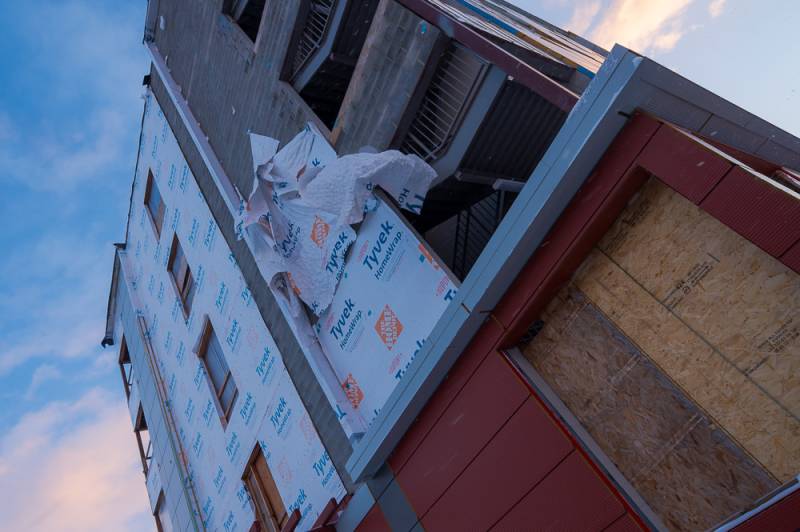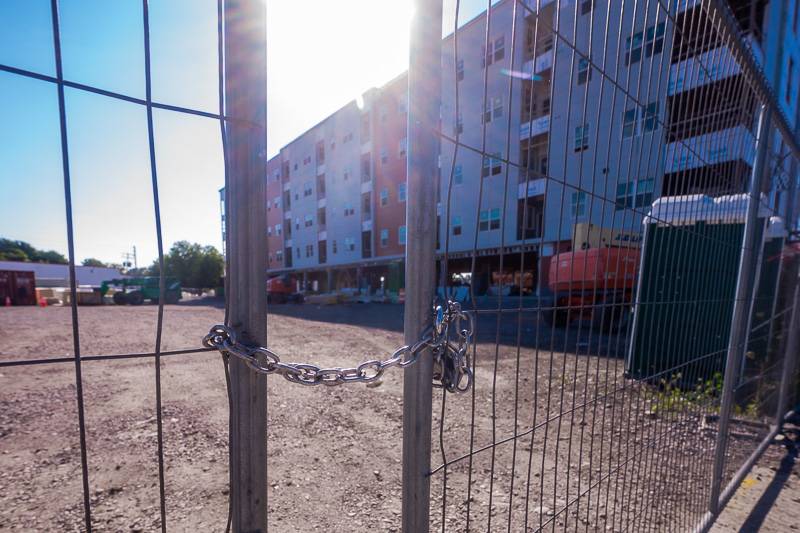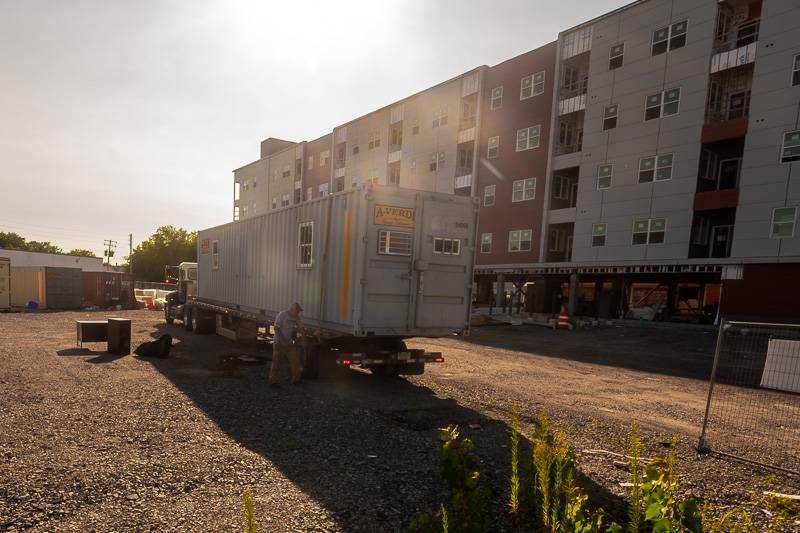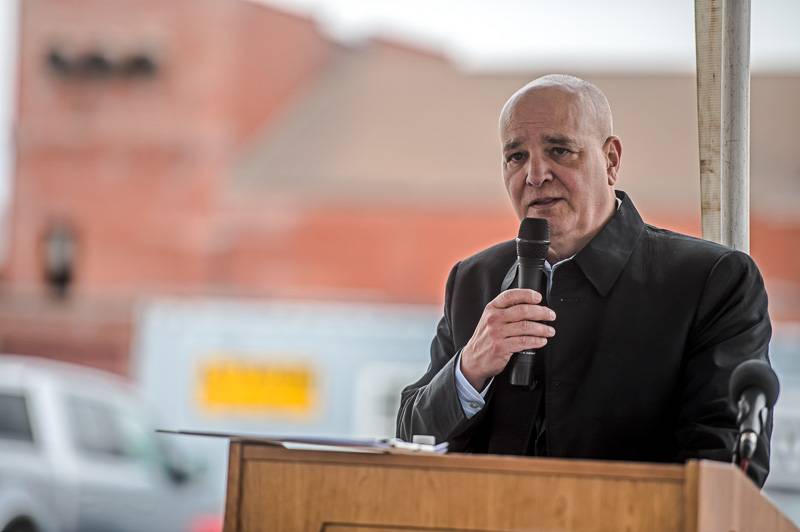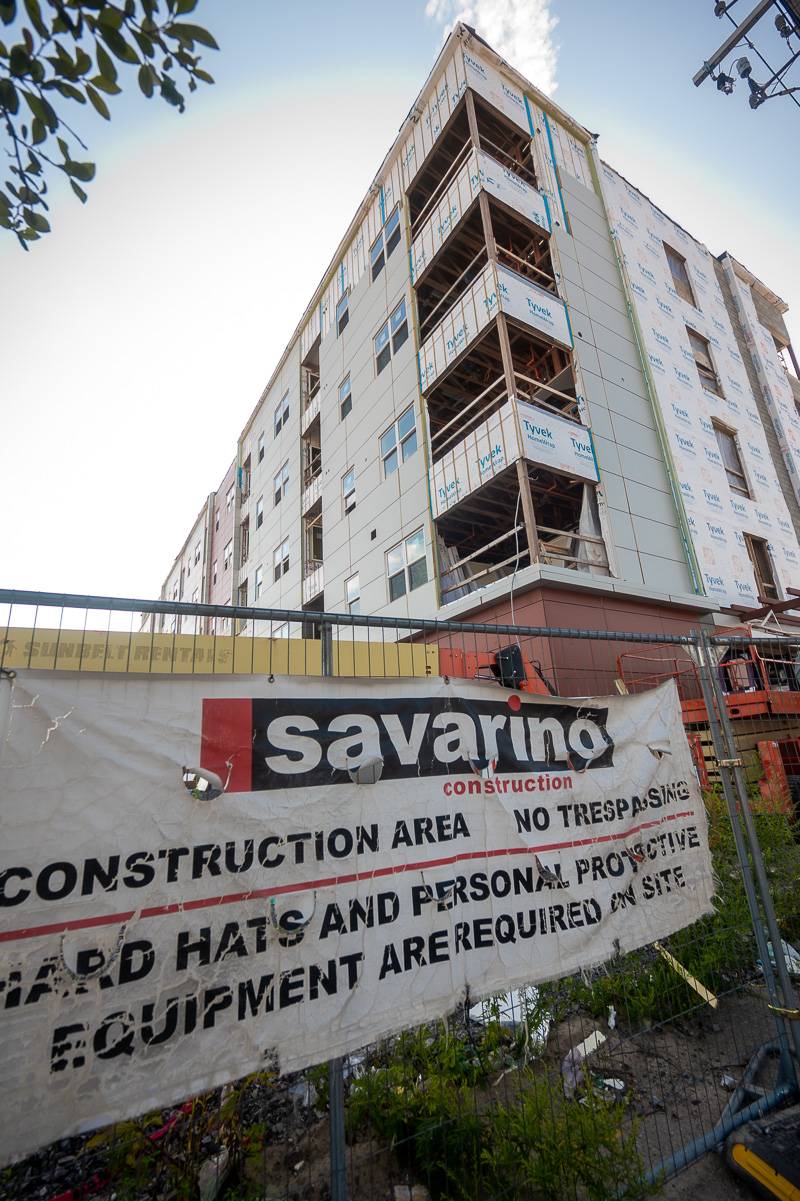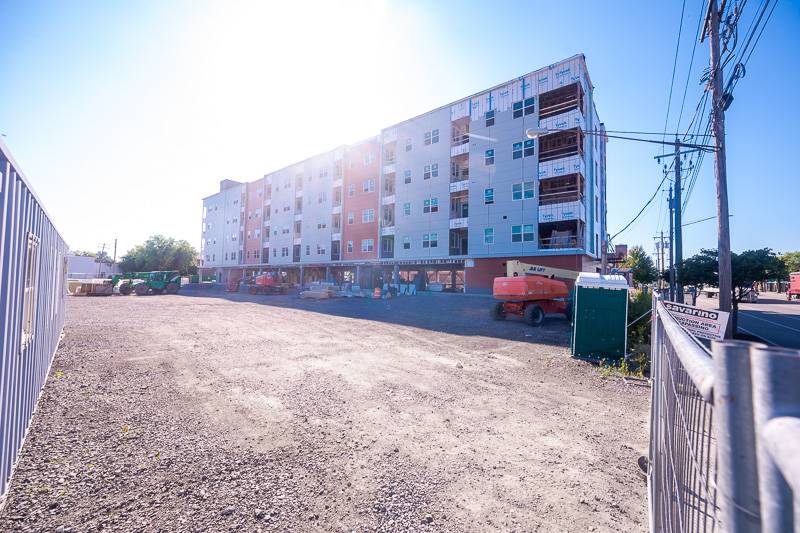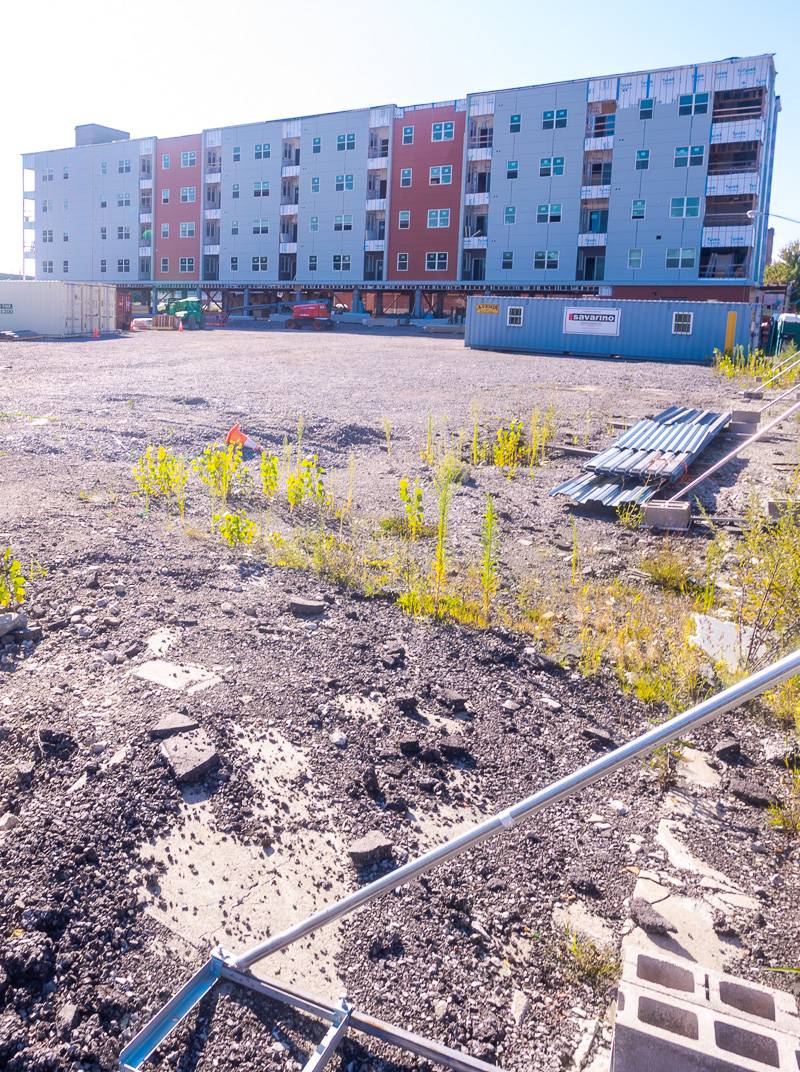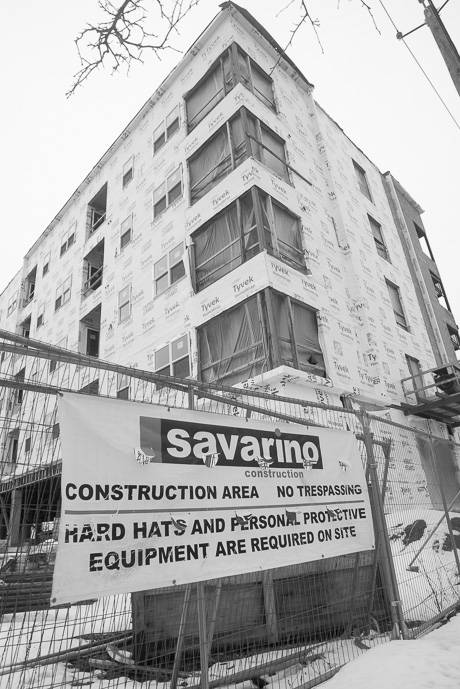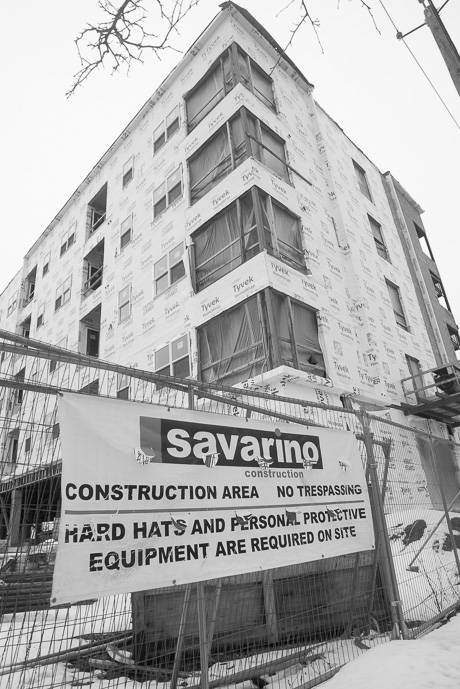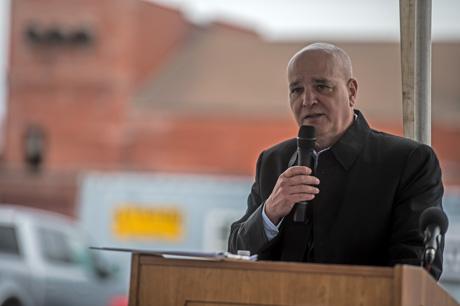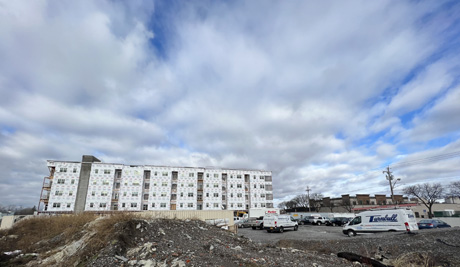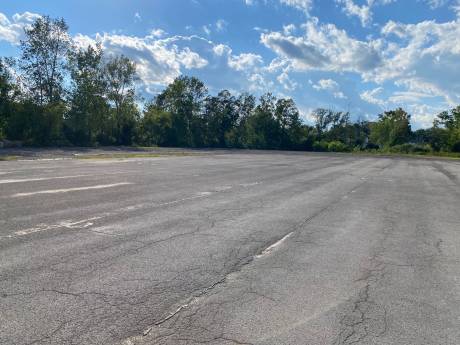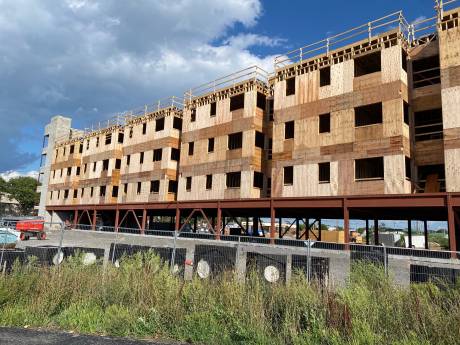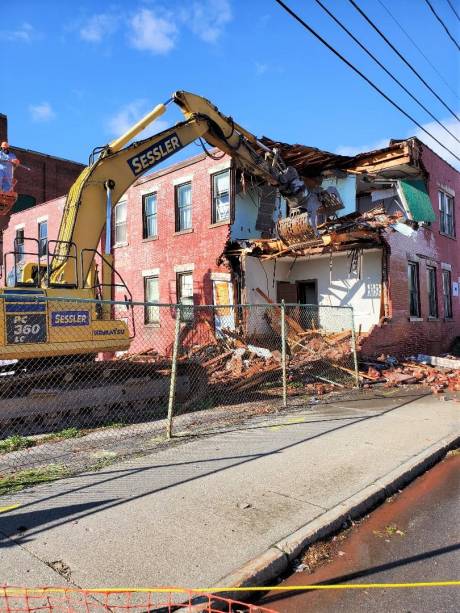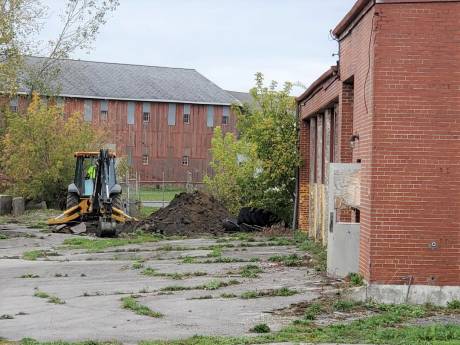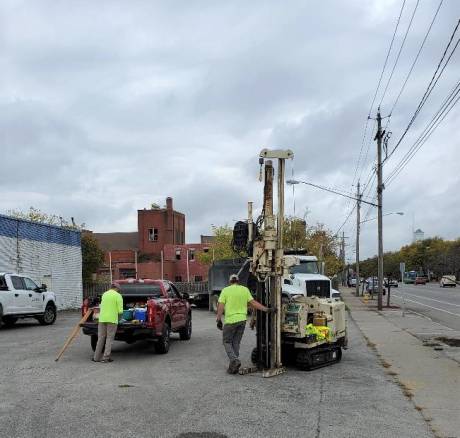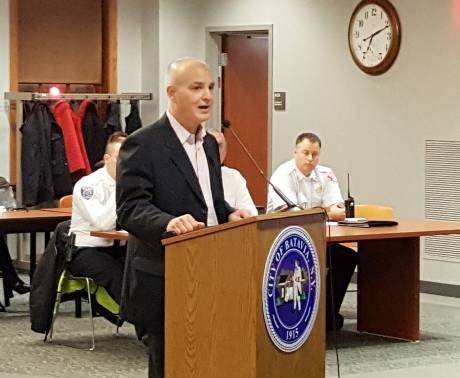Documents reveal Ellicott Station built on foundation of misunderstood housing terms
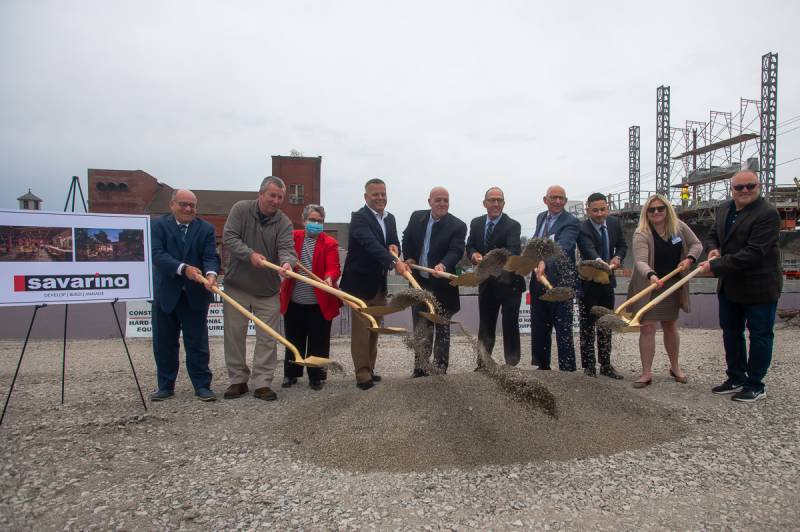
Photo by Howard Owens.
What is mixed-income housing? Workforce housing? Low-income housing? Affordable housing? Market-rate housing?
These terms appear frequently in thousands of documents obtained from government agencies by The Batavian for an investigation into how the 55-unit apartment building under construction at Ellicott Station transformed from “luxury” units to apartments eligible for Section 8 rental vouchers.
How did this once promising project go from a complex where all tenants hold down jobs to one where potentially as few as 36 percent of the potential tenants are gainfully employed, and finally, one where the project's actual completion is in doubt?
As it turns out, the terms bandied about were seemingly often interchangeably in many cases over the years by the developer, Sam Savarino, and representatives of the city of Batavia, the Genesee County Economic Development Center, and NYS Office of Housing and Community Renewal.
In fact, Savarino, in an email about a prior story by The Batavian, suggested the reporter didn’t understand the terms.
"This journalist doesn't seem to realize that workforce, affordable and low-income housing are all pretty much the same thing," Savarino wrote in an email to GCEDC CEO Steve Hyde on Feb. 23, 2023.
But Joanne Beck’s reporting in The Batavian was correct. The terms are not interchangeable; perhaps this is why this critically important community project has become a concern for residents and local government officials.
Housing and Urban Development, the Federal agency that determines which housing projects are eligible for various levels of development and occupancy assistance, has specific definitions for each of these terms.
- Affordable Housing is housing with a monthly rent or mortgage that does not exceed more than 30 percent of a household's income. The definition of “affordable” is entirely dependent on a household's monthly income, whether $2,500 or $5,000.
- Very low income is a term for housing intended for households earning 30 percent or less of the Area Median Income.
- Low income is a term for housing intended for households earning from 30 to 50 percent of the AMI.
- Workforce housing is housing intended for people earning 80 to 120 percent of the AMI. HUD programs are available to subsidize workforce housing.
- Market-rate housing has no income limit and no government assistance. The property owner sets the rent based on the landlord’s assessment of a unit’s worth in a particular market.
- Mixed-income housing is a housing development that aims to accommodate households with income levels from very low income to those who can afford market-rate units without assistance. In a multi-unit complex, there would be tenants with a household income at or below the AMI, those earning 50 percent, 80 percent or more of the AMI, and those potentially with earnings off the charts.
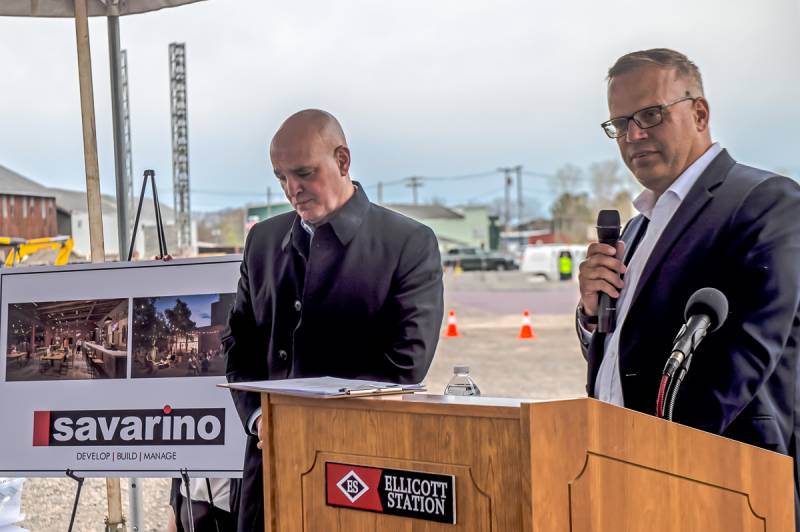
Photo by Howard Owens.
Who are the key players?
- Sam Savarino, CEO of Savarino Companies
- Steve Hyde, the now-retired CEO of the Genesee Economic Development Council
- Rachael Tabelski, currently City Manager for Batavia, but was marketing director of GCEDC when the project first started, then director of the Batavia Development Corporation during much of Savarino's efforts to obtain financing for the project
- Jim Krencik, marketing director for GCEDC
What the records show
Here is a timeline of how the project came to fruition, concentrating on the terms used by officials as they discussed the project and in their promises to others and the community. We've included links to The Batavian's coverage to help provide context to how the project was proceeding.
March 16, 2016, The Batavian, Big plans unveiled today for portion of Ellicott Street, aimed to create 24/7 consumer demand Downtown
Oct. 18, 2016, The Batavian, Local officials trying to spur fast action from ESD on funding for Ellicott Station
Nov. 14, 2016, The Batavian, Developer: Production brewery, 32 apartments comprise Ellicott Station plan
May 25, 2017, The Batavian, Photos: Work begins on Ellicott Station
May 31, 2017, The Batavian, Ellicott Station redevelopment advances with official application for anticipated financial assistance
June 1, 2017, GCEDC board minutes, the board approved a resolution to authorize a public hearing on the project, described as "48 modern market-rate apartments."
June 9, 2017, The Batavian, Developer says the complicated financing for Ellicott Station coming together on schedule
In July 2017, Batavia's Zoning Board of Appeals approved an area variance for the project, which states that the apartment complex will consist of market-rate units.
Sept. 19, 2017, The Batavian, Developer waiting on financing for Ellicott Station project, deal now expected to close in November
Nov. 16, 2017, A memo prepared for a Restore NY grant states the project will be funded in part by a New Market Tax Credit ($9.6 million). The total project cost at that time is $17,745,667. The plan then was for 47 apartment units, not 55.
Dec. 29, 2017, The Batavian, BDC and Savarino finalize transfer of Ellicott Station property
Jan. 24, 2018, The Batavian, Financing on Ellicott Station project expected to close in March
Aug. 10, 2018, The Batavian, Ellicott Station keeps inching toward construction
Aug. 29, 2018, email from Rachael Tabelski, BDC, as a follow-up to a previous day's meeting. "We knew that the Batavia market was untested in terms of a 'market rate' residential development projects of this scale, but we felt there was enough anecdotal evidence, pent-up demand, and small scape comparable upper floor new apartments that we were renting at what we considered market rate (or in this case, around 90 percent of AMI) to support the Ellicott Station Projects rents." She asks for a copy of the market study completed on behalf of Savarino. She would like to set up a meeting to address the $1.8 million funding gap. She offers help with the HCR process and would like to better understand the new potential income mix and rental rates.
Aug. 29, 2018, email from Steve Hyde to Sam Savarino. Hyde notes that there are modest two-bedroom apartments in Batavia of 1,100 square feet in the town of Batavia that are renting for $1,250 a month. "There would be a willingness to pay that more for a brand new contemporary apartment in downtown," Hyde writes. He thinks there might be a way to challenge HCR's market-rate assumptions. "We may need your team's help in interpreting the study as we are by no means housing experts, but I am not sure Lenny's (Lenny Skrill, with HCR) market rate assumptions apply here if the housing stock you are proposing is significantly different than what the basis of housing that was used to calculate market rate rents per study."
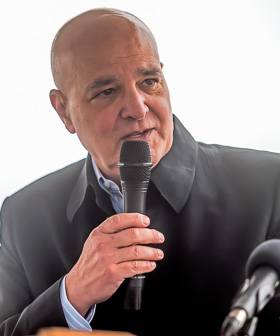
Photo by Howard Owens.
Oct. 3, 2018, email from Sam Savarino to Steve Hyde and Vincent Esposito, Empire State Development, references a summit meeting where all parties agreed a unified application for funds should be made to Homes and Community Renewal. "The HCR requirements, related loss of New Market Tax Credit allocation and attendant leverage debt mean that the project requires $5.4 million of HCR debt. The HCR programs we would be applying for have an aggregate limit of $4.4 million. This leaves us $1 million short. We need a gap filler." There is an attached memo from Savarino CFO Melissa Acquard noting "HCR wanted lower rents," which means "we lost debt service coverage as well as the ability to support the debt." She's estimating there is still a $1 million funding gap.
October 2018, GCEDC board minutes note the complex is being increased from 51 units to 55 units. The square footage has increased from 26,011 square feet to 73,000 square feet. The minutes also discuss the difficulty in making the project viable, given that Batavia's market rents "are depressed compared to nearby metro areas." It states, "Given this, business case adjustments have been made recently, which is impacting the final funding piece of the project. Despite an exceedingly complex capital stack needed to fund this project, all pieces of the funding finalized but one."
Oct. 7, 2018, The Batavian, GCEDC to consider revised assistance for Ellicott Station to help secure state loan
Oct. 18, 2018, email from Rachael Tabelski to City Manager Marty Moore, noting there is still a $1.5 million funding gap that Savarino must close to start the project. She says BDC will work on communication to the community that the project "still remains a high-end 'market-rate' or near 'market-rate' project."
Update in October 2018, a memo from Sam Savarino outlining a possible application to HCR for $3 million, which, if granted, would still leave a $1.5 million funding gap. Savarino's equity is $3.2 million, which includes a discount for construction costs. Savarino is providing guarantees on loans totaling $7.7 million. Resurgence Brewing has stuck with the project up to this point despite the delays.
Oct. 11, 2018, email from Sam Savarino to Steve Hyde, noting that his equity investment in the project is up to $3.8 million. There is still a $1.5 million funding gap.
Nov. 1, 2018, GCEDC board meeting agenda, Ellicott Station is described as "55 new upscale modern near market-rate apartments."
Nov. 19, 2018, Rachael Tabelski, BDC, to Sam Savarino in preparation for a closed session with the City Council about the HCR funding application. Tabelski covers anticipated income levels, which at that point include three market-rate apartments. "This is not a Section 8 'very low-income' project," Tabelski writes.
Nov. 26, 2018, email from Sam Savarino to Steve Hyde and Rachael Tabelski. The memo covers efforts to close the funding gap for the Ellicott Station project. The initial funding gap was $6,154,935. Empire State Development grant of $2.4 million and New Market Tax Credits raised the "gap fillers" to $5.2 million. Savarino's equity investment increased to $850,000 and that was mostly in money already spent or committed. The annual cash flow (profit) has fallen to $42,688, a fraction of what was previously anticipated. Savarino is seeking approximately $3 million from Homes and Community Renewal. Savarino Companies is providing "bridge" financing on all grant funding and full guarantees on all loans.
Feb. 12, 2019, email from Earl Wells with E3 Communications, to Rachael Tabelski, noting that Steve Hyde is concerned about Savarino having the "financial wherewithal to finish the project." He suggests a media strategy of rolling out the project in stages, starting with Phase I, groundbreaking for the brewery. That would be predicated on a meeting Savarino was having with the owners of Resurgence that day.
Feb. 12, 2019, email from Sam Savarino discussing Resurgence (the brewery once slated to occupy the brick building on the west of the property). He has two primary concerns. First, a "drop dead comment date of November, which will be difficult to meet. Second, the project will be 65 percent complete before the Resurgence lease starts. Items he thinks he can offer the owners in return for changes in the lease, such as an opaque temporary barrier wall to minimize construction disturbance from the residential building and offering additional work, such as shade trees, in the beer garden.
March 19, 2019, letter from Sam Savarino to Steve Hyde requesting consideration for a $925,000 Downtown Revitalization Grant. "As you are aware," Savarino writes, "there have been several challenges to getting this project closed and underway. The most recent -- and most considerable -- challenge has been the provision for funding for the residential project. This has forced us to subdivide the project to allow a separate site for the residential project and forced us to abandon the New Market Tax Credit."
May 31, 2019, email from Jim Krencik to Steve Hyde summarizing a conversation about plans for Ellicott Station. Income levels from $30,000 to $51,000, $36,000 to $61,000, and $43,000 to $61,000, depending on unit size, with three units carrying no income restriction. "No knuckleheads," it states. "No subsidies to housing/HUD (all direct pay), no supportive mental health/substance abuse units (already served in public and supportive housing modes), a 'no tolerance' policy for drug use/malfeasance." The goal is to attract and retain talent. The target market is millennials, young professionals, and downsizing empty nesters. "The folks who will be enjoying an IPA at Resurgence!"
July 11, 2019, The Batavian, Hyde calls upon Cuomo to jump-start Ellicott Station
Sometime before July 2019, memo planning for groundbreaking from Steve Hyde. The memo describes the housing as mixed between 50 to 60% AMI, 60 to 80%, and three units at market rate. Hyde states that the main factors in communicating to local leaders, "Project is not a low-income development -- has income minimums," and that "renters are direct pay -- no subsidized payments/vouchers from government."
On or about July 22, 2019, Joe Quinn, an intern with Savarino Companies, supplies a sample letter of support for local officials to send to HCR that describes the project as "mixed-income" with a "predominance tragedy at low and moderate-income tenants." The background informs officials, "Our project will include funding from Low-Income Housing Credits, State Low-Income Housing Credits, Housing Trust Fund, and Middle Income Housing Program. It also describes the project as "mixed-income/workforce housing."
July 22, 2019, an email from Steve Hyde to Savarino Companies said, "Guys, who is Joe Quinn? This email he just sent flies right in the face of the position we've talked about all along and the reservations over more affordable housing in Batavia. Hyde notes prior conversations said the complex would include market-rate housing, is mixed-income, and "is not open to certain populations has income minimums."
July 23, 2019, email from Sam Savarino to Rachael Tabelski, and Steve Hyde. "Not sure who was contacted but I recognize the timing is bad on this. Joe is following the direction of the HCR consultant and is gathering pro forma letters of support required for the application."
July 23, 2019, email from Jim Krencik to Courtney Cox, Krenick seeks clarification on income levels, stating that his notes from a May conversation, the majority of the one-bedroom suites were set for a minimum income of $30,000 and a maximum of $51,000, with two-bedroom suites set for $36,000 to $61,000 in annual income.
July 24, 2019, email from Rachael Tabelski to stakeholders, including all council members, and states, "The rent plan has been carefully crafted, with the assistance of HCR, utilizing professional third-party market analysis to meet the affordability needs of the broader Batavia community, not just those that earn the most, and to ensure the long-term success of the project." The average rent will be $897 a month. Income levels:
- 7 units at $25,600 to $51,000 annually
- 26 units at $30,000 to $51,000 annually
- 2 units at $33,800 to $51,000 annually
- 2 units at $30,600 to $61,200 annually
Aug. 13, 2019, The Batavian, Ellicott Station project status, condition of the property have City Council members speaking out
Fall 2019. A report by Joseph Sievert, a senior appraiser with Newmark Knight Frank Valuation & Advisory, a company based in Buffalo. The project is described as mixed-use, 55 apartments, targeted to households at or below 50 and 60 percent AMI. The project will "replace blight with affordable workforce housing." It states that the IDA (GCEDC in this case) has advised the projects are consistent with its economic development plan, which involves the creation of jobs paying $15 to $18 an hour. The report states Batavia needs more affordable housing. It states that 45 percent of renters pay more than 30 percent of their gross income in rent. "There remains an extensive unmet demand for affordable housing for the income groups and population served by this project," the report states. "All of the existing affordable options in the PMA have extensive waitlists, limited turnover and extended wait times. (NOTE: A prior housing study by the County found there is also a shortage of market-rate housing).
Fall 2019, Savarino application to HCR. The application narrative refers to the project as "workforce housing." It states, "The project will create affordable workforce housing to serve the unmet housing needs of the low-income/entry-level workforce." And that it "affords ordinary workers (an opportunity) to live near jobs." It notes that the IDA advises that rent is set at levels consistent with the local economic development plan, with pay in the range of $15 to $18 an hour (note: for a full-time job, that is $31,200 to $37,440 annually).
Sept. 4, 2019, in an email, Steve Hyde informs city officials that "GCEDC is actively engaged with Savarion Companies in support of efforts to secure HCR funding for the mixed-income housing portion of Ellicott Station."
Oct. 9, 2019. Courtney Cox, with Savarino Companies, requests a waiver from Michael DeBonis with HCR for the size of two-bedroom units. The completed architectural plans call units that will exceed HCR's 970-square-foot limit. "These units exceed the maximum allowable area because the building was originally designed as market-rate housing over a year ago," Cox wrote. "During the course of the development, the program shifted to affordable housing as we recognized the need for new, quality affordable housing in this Downtown Revitalization Area."
Nov. 5, 2019. In an incentive proposal document, Savarino Companies lays out project costs, which total $19,852,873. That includes $60,000 for property purchase, $13 million for construction and renovation, $2.6 million for site work, and $3.7 million in other project costs.
Nov. 22, 2019, The Batavian, DEC opens comment period on Ellicott Station site cleanup
Nov. 25, 2019, The Batavian, Developer hoping for construction start on Ellicott Station in the spring
Nov. 26, 2019. In a certified mail letter to Batavia City Manager Martin Moore, Sam Savarino informs the city of his company's intention to apply to HCR for assistance. He states the company will seek assistance under the Low-Income Housing Credit Program and the NYS Low-Income Tax Credit Program. He notes that under IRS rules, Savarino can't make the application without notifying the local jurisdiction's chief executive officer and notes that the local jurisdiction has an opportunity to comment on the project.
Nov. 27, 2019. HCR approved the request for a waiver on the size of the two-bedroom apartments.
Dec. 6, 2019. A letter from Steve Hyde to Sam Savarino. The letter notifies Savarino that the GCEDC board of directors has approved $3.25 million in tax incentives for Ellicott Station. This includes a 30-year PILOT for the workforce housing portion of the project and a 10-year PILOT for the commercial portion of the project. The letter acknowledges that Savarino Companies is applying to Homes and Community Renewal for 9 percent multifamily housing assistance.
Dec. 9, 2019, The Batavian, Ellicott Station update: Savarino Companies to file funding application with HCR on Friday
Dec. 10, 2019. In a letter from HCR marked "confidential," Hunt provides Savarino with a letter of agreement to form a partnership. Hunt would receive 99.99% of the new corporation. Hunt would acquire financing for Federal Low-Incoming Housing Tax Credits ($12 million), State Low-Income Housing Tax Credits ($5 million), and State Brownfield Tax Credits ($2.3 million).
Jan. 27, 2020, The Batavian, Council perplexed over Ellicott Station situation
March 5, 2020, the GCEDC board approves a resolution authorizing an agreement with Savarino Companies to build 55 mixed-income multifamily residential apartments.
June 2020, GCEDC board meeting minutes refer to Ellicott Station as "55 new modern workforce housing apartment units (max incomes $32,000 to $38,000)."
July 30, 2020, The Batavian, BDC board members speak out over lack of security, activity at Ellicott Station site
Sept. 16, 2020, The Batavian, BREAKING: NYS Homes and Community Renewal approves $5,691,573 award for Ellicott Station
Sept. 17, 2020, The Batavian, Savarino says HCR low income tax credit allocation is vital piece to moving Ellicott Station forward
Oct. 26, 2020, The Batavian, State grants earmarked for Ellicott Station enhancements give Council members a ray of optimism
April 2, 2021, The Batavian, Ellicott Station developer: Deal could close in May; paving way for demolition, construction
July 8, 2021. HCR is notified of a project delay. Because of COVID-19, there is market uncertainty and the original equity investor, Hunt Capitol, was unable to secure an investor at the monetary amount described in the HCR application. No investor was willing to buy Brownfield Tax Credits at all.
July 16, 2021, The Batavian, With key closing dates in place, Ellicott Station developer says remediation work will begin this fall
Nov. 17, 2021. According to a document obtained from HCR, the total development cost is $20,597,736, with a total construction cost exceeding $14 million. It lists a developer fee of $2.3 million and working capital of $209,620. HCR financing is $5,691,573 from the Low-Income Housing Trust Fund Program, an ESD Restore NY loan of $500,000 at 3% interest, and a state Downtown Revitalization grant of $425,000. It states there are to be 16 one-bedroom units for residents with an income not to exceed 50% of the AMI, 19 one-bedroom with income not to exceed 60% of the AMI, and 20 two-bedroom with rent to not exceed 50% of the AMI.
Oct. 15, 2021, The Batavian, Pre-construction work, environmental testing taking place at Ellicott Station; demolition could begin in November
Oct. 25, 2021, The Batavian, City Council voices displeasure with lack of progress at Ellicott Station as it approves grant to help developer
Nov. 3, 2021, The Batavian, And the walls come tumbling down. Demolition is underway at Ellicott Station
April 25, 2022, Mark Masse, then VP of operations for GCEDC, signs a regulatory agreement that refers to Ellicott Station as a "low-income" project.
May 3, 2022, The Batavian, Local leaders and developer celebrate groundbreaking for 'affordable' Ellicott Station in Batavia
May 3, 2022, a statement by Sam Savarino at the groundbreaking: "We discovered the hard truth. We went out and did a market study, which indicated that, well, people in Batavia are not going to be able to come out here and spend over $3,000 a month in rent for apartments. And on top of it, those aren't the types of apartments that are needed. A lot of time, attention and resources are being directed to bringing jobs to this community. But it's not going to mean half as much if the people that come and work at those jobs and then have to go to Buffalo or have to go to Rochester to find a place where they can afford to live. Better to keep them in this community participating in this community."
In a separate interview with The Batavian, he said, "It’s difficult for people to afford to house, and then there’s a shortage of quality, affordable housing. In any event, the market study showed that there was a top end of the market that people could afford to pay in this area; otherwise, it wouldn’t be successful.” He said tenants would be making $20 an hour and below. “The idea being that nobody should be expected to pay more than a third of their income for occupancy that includes rent, or a mortgage, and their utilities,” he said. "Part of the idea was if you’re creating jobs here, you want to have safe, modern quality housing for those workers that they can afford.”
Oct. 24, 2022. Jim Krencik to Courtney Cox at Savarino Companies, asking if the AMI levels for the projects can be increased. She responds that the limits "remain the same as when the project agreements were approved."
Jan. 5, 2023, The Batavian, In the market for affordable housing? Ellicott Station is taking names
Jan. 13, 2023, email from Jim Krencik, marketing director for GCEDC, to Tammy Hathaway, BDC director, with guidance on how to answer questions from The Batavian's Joanne Beck. Beck was trying to clarify, after getting a bit of a runaround from local officials, what kind of housing was planned for Ellicott Station, whether it was a workforce or low-income. She asked specifically if it would be subsidized housing. The narrative, he says, is that students graduating from Cornell in High School, new at a company, will be among the tenants, and they won't be kicked out when they get promoted. He shares that income will be based on Area Median Income, with 60% for 30 units and 50% for 25 units being the income levels. "Focus on that, not technical terms," he writes. "It's hard to 'see it' until your friend, your niece or nephew, your co-worker is living there."
Jan. 16, 2023, The Batavian, New apartment complex to serve entry level workers as viable housing option
Jan. 31, 2023, minutes from a meeting of local officials with Sam Savarino. Tammy Hathaway, Batavia Development Corp., provides background on Section 8 housing and affordable housing. Steve Hyde raises the issue of whether "affordable housing" becomes low-income housing, noting GCEDC has worked to promote workforce housing. Courtney Cox, with Savarino, notes that rental rates are set at 2021 income levels, and can't change until one year after the complex is operational. Jim Krencik, with GCEDC, wanted to know how the agencies and Savarino can work cooperatively with new, young workers. Sam Savarino suggests a collaborative effort to tell the story of what the building is, to use "poster child" tenants. Sam apparently notes, "can't afford to stub our toe." Also present, Rachael Tabelski, city manager.
Feb. 18, 2023, The Batavian, Apartment application reveals for first time, Section 8 vouchers accepted at Ellicott Station The Batavian reported at the time that no official would confirm that Section 8 vouchers could be used for the project. The Batavian reported:
As it turns out, a single person living alone making $18 an hour is making too much to qualify for an apartment at Ellicott Station, though that same person with two or three dependents, meaning no additional income, would qualify.
Whereas two people each earning minimum wage, $14.20 an hour, are not eligible for a two-bedroom apartment at Ellicott Station because they would be earning too much (the maximum household income for two people in a two-bedroom apartment is $34,600, and two people working full-time at $14.20 would gross $59,072).
Feb. 18, 2023, The Batavian, OPINION: Ellicott Station is not looking like a 'Pathway to Prosperity
Feb. 19, 2023, email from Rachael Tabelski to Sam Savarino. Tabelski notes The Batavian's coverage and the concern it has raised among community leaders. "They believe this will be run-down 'project' housing in no time, and we're sold workforce housing and got extremely low income, not middle income."
Feb. 19, 2023, email from Steve Hyde to Sam Savarino with a screenshot of the flier being used to market Ellicott Station. Hyde states, "Nothing about workforce housing ... implies largely the opposite in many respects."
Feb. 19, 2023, email from Steve Hyde to Sam Savarino. Hyde notes that weeks before, there was a meeting to discuss managing the narrative of the rental marketing. "That opportunity has come and gone with info published recently on the state website about the project that characterizes this project completely differently than how I understood it." He says that several GCEDC board members are feeling misled. He hopes the project can be reframed to be truly workforce housing. "The first I heard of Section 8 vouchers was at our meeting two weeks ago."
Feb. 19, 2023, email from Sam Savarino to Steve Hyde. Savarino says he and his colleagues hear Hyde "loud and clear." He says, "We will do what we can to ensure that the project is accurately portrayed. "I would also note that Ellicott Station is no different than any other property/landlord when it comes to complying wth fair housing laws and Section 8 vouchers."
Feb. 21, 2023, The Batavian, City leaders surprised by Ellicott Station's income levels, ask developer to raise them
Feb. 23, 2023, in a letter from Sam Savarino to Steve Hyde, he states, "The fact that incomes have recently risen dramatically and income restrictions are static to 2019 -- and cannot be updated until next year -- might be evident in a detailed analysis of the income restrictions versus potential workforce tenants."
Feb. 27, 2023, The Batavian, Ellicott Station developer, GCEDC excited about project for tenants to 'live, work and play'
Late February 2023 (letter undated), from Steve Hyde to Sam Savarino. The letter addresses some requests from area officials that there will be on-site management, that there be a preference in selecting tenants from Genesee County, the renting process includes background checks, an annual report on whether the project is meeting workforce housing goals, and statistics on occupancy. The letter states, "The current flier and website, along with the HCR brochure, have not effectively messaged the strong commitment you've shared to accomplish a workforce housing model for working residents. This has created some real concern for several elected officials and community leaders who were expecting a powerful marketing effort to attract working residents with modest incomes to Ellicott Station."
March 7, 2023, Sam Savarino responds to Steve Hyde's letter. Savarino says the project is important to the community and to his company and states, "We remain confident that Ellicott Station will be a true asset to the community and help address identified housing needs and demands in the marketplace." He states all tenants will be screened and go through a "rigorous vetting process within the bounds of New York State and federal law and regulations." He states the company has been diligent in trying to get the word out about the complex to lower-income workers and that the company will produce an annual report on meeting workforce housing goals. He attached the "Ellicott Station Apartments Tenant Selection Plan." The plan discusses advertising and "postings at Section 8 rental assistant offices and that it will be listed in "Affordable Housing Opportunities," which is distributed widely in Erie and Niagara counties. For applicants, income will be verified, credit history will be reviewed, and criminal background history will be included. Reasons for rejection of applications include not meeting income requirements, conviction for product meth, and lifetime registrant on the state sex offender registry.
March 13, 2023, City Council sent a letter to RuthAnne Visnauskas, commissioner and CEO of HCR, asking HCR to modify the income requirements for Ellicott Station, expressing the view that it was the council's understanding that when Savarino turned to HCR for financial assistance, it was to construct a mixed-income complex but that HCR directed Savarino to provide a low- and very-low-income complex. The letter states that Savarino said this income level would align with the area's emerging manufacturing workforce, college students, and active seniors. "The city of Batavia supported the application of Savarino Companies to HCR as a mixed-income workforce housing project that closely aligned with the City's DRI strategy." It states that HCR required changes to the project, and the project no longer aligns with that vision. The letter notes rising wages as a further barrier to attracting workforce tenants. It also notes that other HCR-backed projects in other communities in Upstate New York have been allowed to set rents at 80 to 120 percent of AMI. "We feel this (income level) will encapsulate the workforce housing that we were promised," the letter states.
March 14, 2023, The Batavian, Ellicott Station is going up, city leaders ask for income levels to do likewise
March 15, 2023, Steve Hyde emails city and county officials along with GCEDC board members a copy of a letter signed by City Council members petitioning HCR to modify that calculation of Area Median Income so that inflation is taken into account. Hyde writes, "... capping incomes at pre-pandemic levels for a workforce housing project just limits the ability of our working residents with modest incomes to meet the criteria to live there. That undermines the nature of the project, which was to target and provide quality workforce housing for entry-level workers for area manufacturers."
April 6, 2023, Rachael Tabelski's email to Sam Savarino to ask for a conference call that would include other stakeholders, including Lenny Skrill from HCR, to explore options for increasing the project's AMI. She said she would also like to hear how Savarino can "keep your promise that all tenants will be employed." She also expresses concern that there have been material changes to the building, such as eliminating ceramic tile, washers and dryers, and metal ramps into showers for handicapped residents.
May 3, 2023, email from Steve Hyde to Kylie Gordon, development operations manager for Savarino. Hyde requests information on lottery winners, including total number of applicants, a blind list of addresses of lottery winners, numbers per household, number of disabled and not working, number retired, wages of employed and self-employed winners, lottery winners currently unemployed, and number of winners eligible for Section 8 assistance.
May 5, 2023, The Batavian, Lottery drawing selects 55 tenants for Ellicott Station, Savarino says
May 9, 2023, The Batavian, One woman's dream comes true as first one chosen for Ellicott Station
May 17, 2023, Sam Savarino informs Rachael Tabelski in an email that HCR has informed him that they will not agree to reset the AMI.
May 22, 2023, email from County Manager Matt Landers to Steve Hyde. "Vicky and Tammie participated in the monthly Genesee County Housing Initiatives Committee meeting this morning, and the representative for Ellicott Station participated and definitely wasn't giving answers that made the group feel good. My understanding was that there would be a genuine attempt to get Genesee County residents into Ellicott Station, where Kylie was adamant that they cannot and will not give Genesee County residents priority. Secondly, I was under the impression there would be a real attempt to vet candidates before the lottery process to try and get people that were gainfully employed and Kylie said any type of vetting would be done AFTER the lottery."
May 23, 2023, email from Steve Hyde to Sam Savarino. Hyde had previously requested information on the lottery winners and found the response insufficient. "We are trying to determine if the large majority of 'lottery winners' are gainfully employed and the related demographics. That information, he says, would help him report to his board and the city if the project is meeting the goals of 'workforce housing' as portrayed in the Savarino project description of Dec. 20, 2019.
June 21, 2019, an email from Kylie Gordon to Steve Hyde provided some demographic information on lottery winners. Of the 53 winners who are still interested, 42 are from Genesee County.
June 2023, GCEDC board minutes. The board approved a resolution directing attorneys to send a demand letter to Savarino for information previously requested about lottery winners. It passes unanimously. The discussion notes the project morphed from market-rate to mixed-income to workforce and that workforce would mean "affordable housing for those at the 50-60% of area median income, essentially those working at our Main Street businesses and entry-level manufacturing positions."
June 23, 2023, email from Steve Hyde to Sam Savarino on residential application status. Savarino notes that 79 percent of the lottery winners are Genesee County residents and mostly from Batavia. Only 10 percent are from outside the GLOW region. Hyde characterizes this as "good news." There are 13 applicants on disability. Hyde would like to know how many of those on disability were also employed.
July 13, 2023, letter to Sam Savarino from GCEDC attorney Russell E. Gaenzle. It is a notice of default for not complying with the terms of the project agreement to provide workforce housing and provide GCEDC-requested documentation related to the composition of potential tenants who were selected in the lottery.
July 31, 2023, letter from Sam Savarino to GCEDC attorney Russell E. Gaenzle. Savarino makes the following assertions:
- "Our examination of the documents you have provided us indicates that we are developing and constructing exactly what we applied for, and that was considered, approved, and resolved by GCEDC and what was formally provided and received by the city of Batavia."
- "We have followed regulations and laws in advertising for and selecting tenants who have yet to go through the screening and vetting process."
- "That we actively solicited 'workforce' tenants in conjunction with local workforce development agencies and targetted advertisements."
- "That we ought not to be held to arbitrary and malleable standards to determine whether the goals have been met."
- "That we cannot impose restrictions or standards for selecting tenants that do not comply with regulation and law."
August 2023, GCEDC board minutes recapping a June 29 board action on Ellicott Station. The board declared the project in default for failing to provide sufficient information about the housing lottery. The board also found that the information that Savarino provided on July 31 indicates there is an insufficient number of lottery winners that meet GCEDC's definition of workforce housing, "which is aligned with the industry definition as well."
Aug. 22, 2023, The Batavian, Savarino Companies going out of business, leave Ellicott Station up in the air
Aug. 23, 2019, letter from Russell E. Gaenzle, attorney for GCEDC, to Sam Savarino. It is a second notice of default under terms of the project agreement. It alleges that Savarino Companies are not meeting the goal of providing quality workforce housing for working residents of Batavia. "The term 'workforce' generally includes those who are not typically the target of, or eligible for, affordable housing projects (such as those at or above the median income). This usually includes essential workers in the community, such as firemen, nurses, and medical personnel." The letter notes only about 36 percent of the lottery winners are gainfully employed. GCEDC intends to recapture incentives under terms of the agreement "when 'the company has made a materially false or misleading statement, or omitted any information which, if included, would have rendered any information in the application or supporting documentation false or misleading in any material respect." The letter demands that Savarino cure the default by petitioning HCR to increase the AMI to 80% to 120% of AMI, and if that isn't feasible, demand HCR increase the AMI so the 50% to 60% threshold includes higher wage earners.
Aug. 23, 2023, The Batavian, Documents say Savarino defaulted on financial agreements, GCEDC and city work on 'next steps'
Aug. 24, 2023, The Batavian, Savarino explains reason for business closure
Aug. 24, 2023, The Batavian, Dealing with communication shutdown: 'a long process,' city manager says
Aug. 25, 2023, The Batavian, HCR's role for Ellicott Station: to 'deliver 55 affordable homes to Batavia'
Sept. 1, 2023, The Batavian, Apparent construction office for Savarino Companies removed from Ellicott Station site
Sept. 12, 2023, The Batavian, Developers are interested in Ellicott Station, a 'complex situation'
Sept. 17, 2023, The Batavian, Prospective Ellicott Station tenants advised to explore 'alternative housing'
Sept. 19, 2023, email from Douglas Randall, city code enforcement, to Sam Savarino about concerns that "defects in the building envelope may result weather deterioration of the wood frame structure and freezing damage to plumbing and/or mechanical systems."
Sept. 22, 2023, The Batavian, County officials optimistic about Ellicott Station while prospective tenants mull legal action
Oct. 4, 2023, The Batavian, Photo: Workers stop by Ellicott Station project
Nov. 20, 2023, notice of recapture sent to Ellicott Station, LLC by GCEDC, stating the agency seeks to recapture $831,577.23 and $281,518.40 in incentives.
Nov. 29, 2023, The Batavian, GCEDC terminates agreements with Savarino, asks for $1M back
Dec. 1, 2023, letter from Sam Savarino to Steve Hyde, objecting to the "recapture" proceedings and termination of the agreements between Savarino Companies and GCEDC. He says there is "no basis for the termination." He denies Savarino Companies is in default and rejects the assertion that his company made "materially false or leading" statements. He states, "... the 55-units were to be 'workforce' housing, which the agency claims 'generally includes those are are not typically the target of, or eligible for, affordable housing programs" and with income of 80% to 120% of AMI.
"The agency cannot credibly claim that the company made a false or misleading statement in its application. Numerous emails between you and myself or Oxford Consulting reflect your and the agency officials' knowledge and agreement that the 55 units of housing would be limited to occupants with income below 60% of the area median income." Later, he states, "The agency's awareness and acquiescence to this income restriction is further reflected in the Low-Income Housing Regulatory Agreement, dated April 15, 2022, among the company, the agency, and DHCR." Later, "Nor could any such promise be made or enforced. As you are well aware, the company cannot legally discriminate against unemployed applicants who otherwise meet the income requirements or otherwise ensure that the units go to a certain percentage of employed occupants."
He notes that the project's income levels cannot be increased to 80% to 120% of AMI and still qualify for housing tax credits. He concludes, "There is simply no basis to contend that the company in any way misled the agency, which is the only claimed cause for termination of the agreement. we respectfully request that the agency reconsider the termination of the agreements and revoke its demand for recapture of benefits thereunder."
Dec. 16, 2023, The Batavian, Some tidying up, holding out hope, at Ellicott Station
Jan. 11, 2024, The Batavian, Contractors seek payment through liens against Ellicott Station LLC for nonpayment of goods, services
Feb. 8, 2024, The Batavian, Photo: Workers install siding on Ellicott Station
Feb. 11, 2024, The Batavian, Developer hints at current, possible future involvement with Ellicott Station project
May 24, 2024, The Batavian, Housing study shows need for low income, workforce, or market rate? Yes to all, consultants say
July 4, 2024, The Batavian, As time marches on, grass grows, taxes compile and answers remain for stalled complex
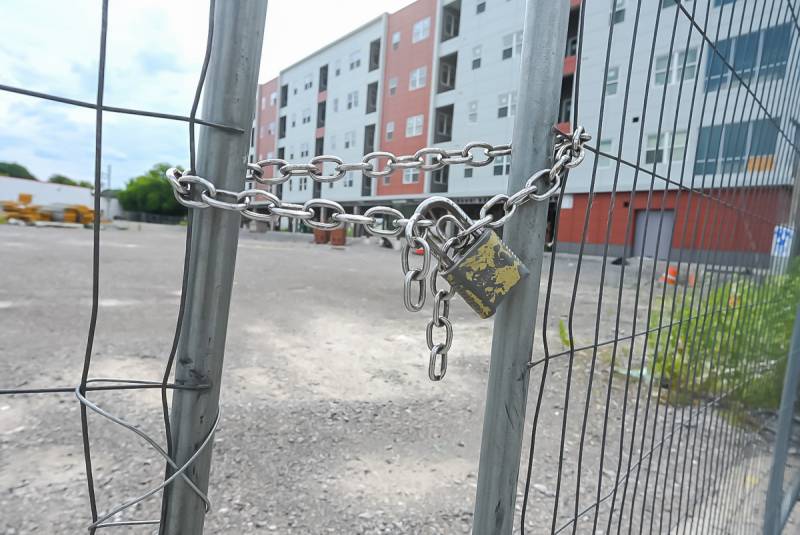
Photo by Howard Owens.
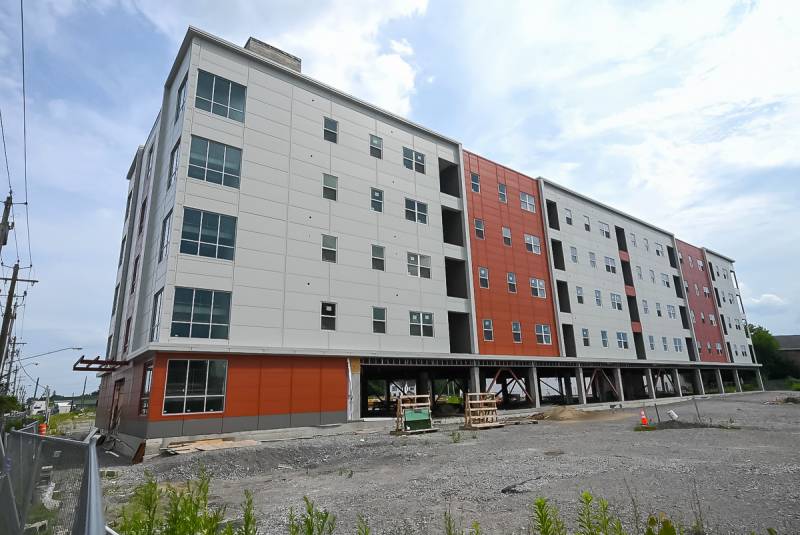
Photo by Howard Owens.

